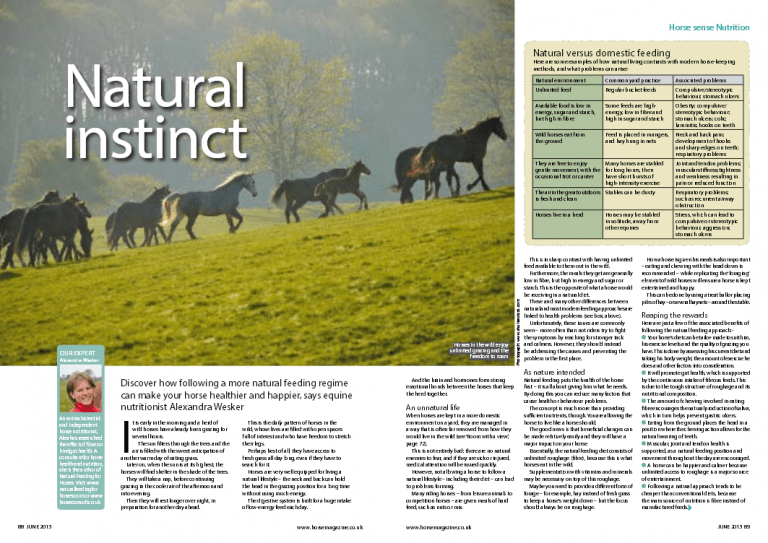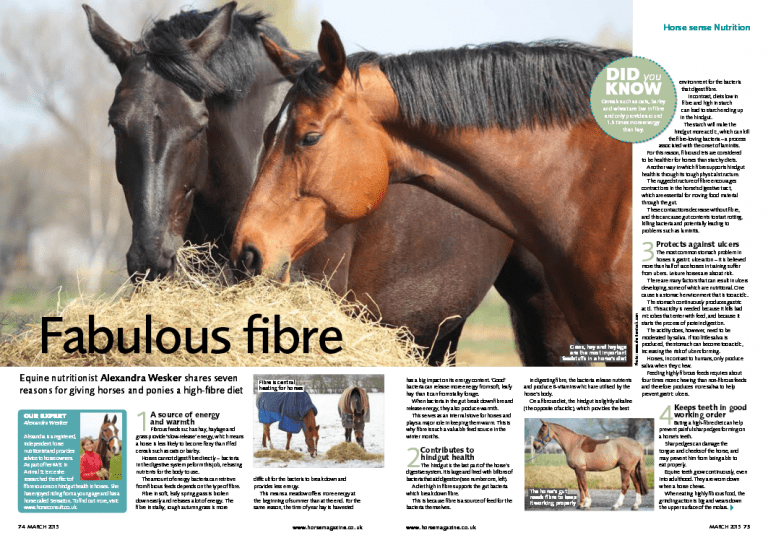Starch: friend or foe?
As published in Horse Magazine
Our expert Alexandra Wesker: Alexandra is an independent horse nutritionist. As part of her MSc in Animal Science, she researched the effect of fibre sources on hindgut health in horses. Visit: www.horseconsult.co.uk.
High levels of starch can cause behavioural issues and weight problems. Nutritionist Alexandra Wesker looks at how to limit it in our horses’ diets.
Starch isn’t essential to horses for survival. The main reason for feeding it is to provide energy for exercise.
Health and behaviour problems can occur, however, if too much is fed. Here are the warning signs of starch overload:
- An increase in body fat
The high-energy content of starch is both its strength and its pitfall. While it is a great source of fuel for a working horse, it is possible to provide excess energy through feeding starch.
Excess energy is stored as body fat, which can lead to obesity. giving the correct amount of energy is key in maintaining a healthy weight.
If your horse needs to lose weight, less dietary energy must be provided.
If your horse has a manufactured feed, switch to one that has a lower energy content.
Manufacturers can decrease the energy content of a feed by lowering its starch or fat levels.
So, if you want a feed with a decreased energy content, you can choose one that has either a lower starch or lower fat content.
It is always advisable to check with a qualified nutritionist before changing your horse’s feed. - Changes in behaviour
When a horse eats starch, blood sugar levels rise as the starch is broken down, digested and enters into the bloodstream.
This rise in blood sugar levels makes horses more energetic.
If this energy is not channelled through a sufficient amount of exercise, it is comparable to feeding sugar to a child and expecting them to sit still and be quiet.
Horses may be spooky or excitable on starch because their energy levels do not match with the behaviour that is requested of them. They can react in the same way to sugar in the diet.
The extent to which starch affects behaviour depends on the individual horse.
If your horse is fed nuts or a mix and shows such signs of unwanted behaviour, look for an alternative product with a lower starch, sugar and WsC content. WsC stands for water soluble carbohydrates, which includes starch and sugar.
If you don’t want your horse to lose or gain weight, ensure the new feed has a similar energy content to what the horse previously had.
Of course, other causes of too much energy when ridden also need to be taken into consideration. For example, if your horse is stabled all day then the only energy outlet he has is when you ride him.
It may be your horse is emotionally stressed, due to not having suitable company.
Or, maybe your horse is in pain and displays in other words, be careful not to blame starch alone for high spirits and consult a vet if necessary.
Other side effects
Fermentation of starch in the horse’s stomach produces gas and acid. Excess acid production, as a result of fermentation, is associated with the development of gastric ulcers.
As horses can’t burp, severely excessive gas production can cause the stomach to rupture. This can be seen as feed rushing out of a horse’s nostrils, in which case call your vet straight away.
Starch that is not digested before it reaches the hindgut gets fermented by the bacteria there.
The hindgut is slightly alkaline (the opposite of acidic) and provides a healthy environment for the ‘friendly’ bacteria to live.
The acid production from fermentation makes the hindgut more acidic, which kills the bacteria.
This process is associated with the onset of laminitis, although the exact pathways are still being studied. Gas production that results from fermentation in the hindgut can cause colic.
Managing starch intake
Cereals – which are often found in manufactured feeds – are the main source of starch in horses’ diets.
This makes the type and amount of cereals the main factor in managing dietary starch content for our horses.
Here are some ways of keeping starch levels healthy in your horse’s diet:
- Spread out starchy meals
Avoid giving large servings of high-starch feeds, such as cereals. Don’t feed more than 0.5g of starch per kg of bodyweight at a time – eg 250g of starch for a 500kg horse. Feed bags may display starch content, or consult the manufacturer’s website or call its helpline. - Limit cereals
Starch content of cereals easily reaches over 50 per cent – way over the maximum of 10 per cent horses might encounter in their natural diet. Avoid feeding more than 2kg of straight cereals per day and ideally feed less than 0.5kg each time. Feed ponies no more than half these amounts. Straight cereals are high in phosphorus and low in calcium and fibre, so seek advice before feeding them. - Feed the right cereals
Starch digestibility varies between cereals. Starch in oats is highly digestible and little of it reaches the hindgut, unless fed in excessive amounts.
Starch in barley is far less digestible and is more likely to reach the hindgut.
If you want to feed starch, then find alternative sources to barley, especially for horses prone to gas colic and laminitis. - Offer more digestible feeds
Processing has a major impact on the digestibility of starch. For example, starch from whole maize is far less digestible than starch from popcorn.
This is because the hard outer shell of whole maize prevents digestive enzymes from reaching the starch.
Starch from ‘rolled’ or ‘crushed’ cereals is only slightly more digestible than starch from ‘whole’ cereals. Digestibility improves if cereals have been ‘ground’ and is best if they’ve been ‘popped’ or ‘micronised’. - Supplement with oil
Fat has a high energy content but doesn’t contain starch. An easy way to feed it is to sprinkle oil over hay.
Oil should be fed at no more than 1gram per kg of bodyweight. Add oil to the diet gradually, by no more than one tablespoon per day.




